Oxtail is a popular ingredient in many cuisines around the world. As its name implies, oxtail is the tail of cattle, specifically the tail of an ox. Despite the name, the meat is not limited to the tail of this particular animal and can be sourced from different breeds of cow as well. While using a cow’s tail for food may seem unusual, oxtail has been a staple in many cultures for centuries. Its versatility in the kitchen makes it a valuable ingredient in various dishes – from stews to soups to curries. So, what is oxtail, and why is it so prized in some parts of the world? Let’s find out.
What is Oxtail?
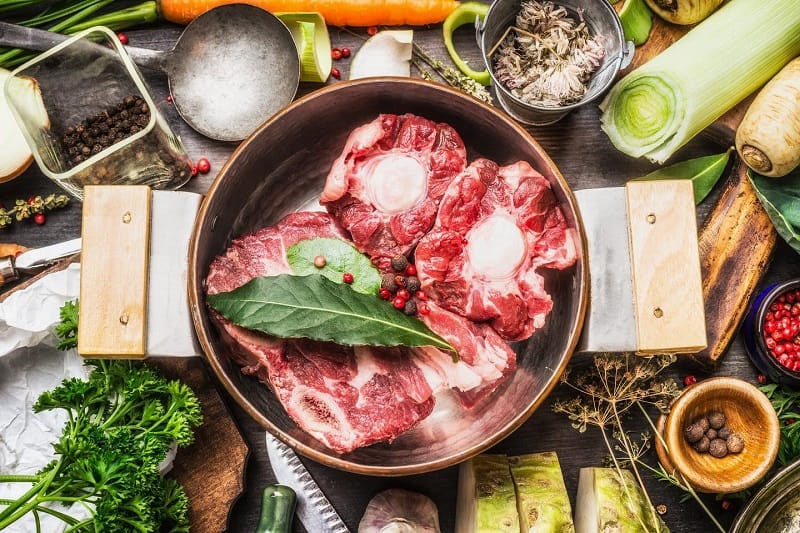
Oxtail is a unique cut of meat that comes from the tail of a cow or calf. Typically, the tail is cut into round pieces about an inch thick and surrounded by a mixture of meat and fat. Oxtail is high in gelatin, which makes it an ideal ingredient for slow braising or stewing.
Oxtail is a popular ingredient in many cuisines worldwide, including Caribbean, African, and Asian. Oxtail is particularly popular in the Caribbean, where it is a key ingredient in the famous Jamaican dish, oxtail stew.
While the name “oxtail” may have originally referred only to the tail of an ox, today, it can also refer to the tails of other cattle. This delicacy is popular worldwide and is often used to create rich and flavorful soups and stews.
Oxtail is a delicious and versatile ingredient that adds unique flavor and texture to various dishes. It pairs well with bold, spicy flavors and more subtle, earthy flavors. It can be used in everything from hearty stews to savory pies and even as a filling for tacos or sandwiches.
What’s Special With Oxtail?
Contrary to what the name suggests, oxtail doesn’t come from an ox. Instead, it’s typically taken from the tail of a cow. The tail is a very muscular part of the animal, packed with flavor and collagen. Collagen is a protein that breaks down into gelatin when cooked, giving oxtail its signature rich and meaty flavor.
One of the best things about oxtail is how versatile it is. It can be cooked in various ways, from slow-cooked stews to braises to soups. Its unique flavor also pairs well with various ingredients, making it a great addition to many dishes.
Another great thing about oxtail is that it’s incredibly satisfying to eat. The meat is tender and flavorful, and the gelatinous texture adds a richness that’s hard to resist. It’s a great comfort food, perfect for warming you up on a cold day or giving you a boost of energy after a long day.
Overall, there are many reasons to love oxtail. From its unique flavor to its versatility to its satisfying texture, it’s a great ingredient for anyone to add to their cooking.
What Does Oxtail Taste Like?
Oxtail is a part of the cow’s tail rich in collagen, making it a popular ingredient in various cuisines worldwide. If you’re unfamiliar with oxtail, you might wonder what it tastes like. Here, we’ll explore the taste and texture of this delicious cut of meat.
To start, oxtail has a rich and beefy flavor that is similar to other cuts of beef. However, it has a distinct taste because of the high-fat content and the added flavor from the bone marrow. The meat from the tail is tender and flavorful, making it a popular ingredient in stews, soups, and curries.
The texture of oxtail is different from other cuts of meat because it contains a lot of connective tissue. When cooked low and slow, the collagen in the meat breaks down, making the meat tender and juicy. This is why oxtail is often used in slow-cooked dishes such as oxtail stew and oxtail soup.
One of the best things about oxtail is its versatility. It can be cooked in many different ways, and each method will bring out a different flavor and texture. For example, oxtail braised in red wine and tomato sauce will have a rich and tangy flavor, while oxtail that is slow-cooked in a coconut curry sauce will have a spicy and sweet flavor.
If you want to try oxtail for the first time, many different recipes exist. Oxtail stew is a classic dish perfect for cold winter nights, while oxtail soup is a comforting and hearty meal that is great for lunch or dinner. Oxtail can also make tacos, sandwiches, and even burgers.
See: https://tiredtexanbbq.com/blog/what-does-oxtail-taste-like/
Why Is Oxtail So Expensive?
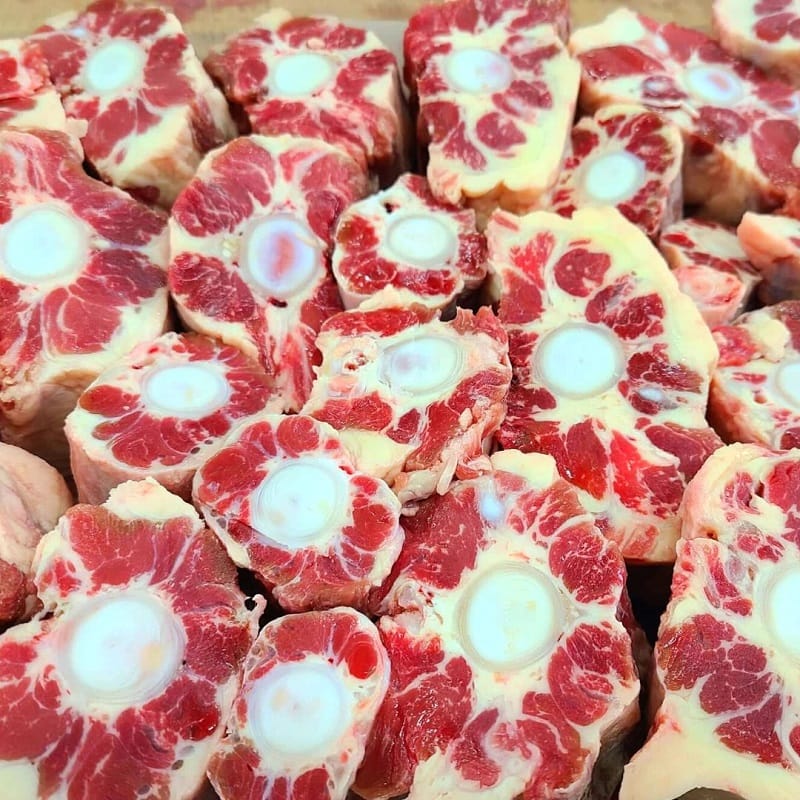
If you’ve ever looked at the price of oxtail at your local grocery store or meat market, you may have been taken aback by the high cost. But why is oxtail so expensive? Now, we’ll explore the reasons behind the high price tag of this flavorful cut of meat.
First of all, let’s define what oxtail is. The tail is a bony, gelatinous cut of meat that is typically used in stews and soups, as well as in braised dishes and sometimes even grilled.
One reason oxtail is so expensive is that it is a relatively rare cut of meat. There are only two oxtails per animal, and they can be difficult to butcher due to the bony nature of the tail. This means that demand exceeds supply, which drives up the price.
In addition to its rarity, oxtail is expensive because it requires a lot of time and effort to prepare. Because the meat is tough and fibrous, it must be cooked slowly to become tender and flavorful. This can take several hours of simmering, which means that preparing oxtail is a labor-intensive process.
Another factor contributing to the high oxtail cost is the trend toward nose-to-tail eating. As more and more people become interested in using every part of the animal to reduce waste, cuts like oxtail become more popular. This means that demand for oxtail is increasing, increasing prices.
Finally, the high cost of oxtail can also be attributed to the quality of the meat. Because oxtail is a relatively tough cut, it is often from older animals with time to develop a rich flavor. This means the meat is of higher quality than other, more tender cuts, contributing to the cost.
Can Oxtail Be Used In Other Dishes Besides Soups And Stews?
Oxtail can also be used in various other dishes besides soups and stews. From pasta dishes to tacos, oxtail can add depth and complexity to a range of meals. We’ll explore the versatility of oxtail and provide some tasty recipe ideas to help you incorporate it into your cooking.
- Using Oxtail in Pasta Dishes: One great way to use oxtail is in pasta dishes. Oxtail ragu is a classic Italian dish that pairs tender oxtail meat with a rich tomato sauce. To make oxtail ragu, brown the oxtail in a pan, then add diced onion, carrot, and celery. Cook until the vegetables are softened, then add canned tomatoes, red wine, and beef broth. Simmer on low for several hours until the meat falls off the bone. Shred the meat and served over your favorite pasta.
- Using Oxtail in Tacos: Another fun way to use oxtail is in tacos. Oxtail tacos are a popular dish in Mexican cuisine and are often served with fresh cilantro, onion, and lime wedges. To make oxtail tacos, first, braise the oxtail in a flavorful broth until tender. Shred the meat and served it in warm tortillas with your favorite toppings.
- Using Oxtail in Curry: Oxtail also works well in curry dishes. The rich flavor of the meat pairs well with bold spices and creamy coconut milk. To make oxtail curry, brown the oxtail in a pan, then add diced onion, garlic, and ginger. Cook until the vegetables are softened, then add curry powder, cumin, and coriander. Add coconut milk and simmer on low for several hours until the meat falls off the bone. Serve with rice and naan bread.
- Using Oxtail in Chili: If you’re a fan of chili, try using oxtail in place of ground beef. Oxtail chili is a hearty and flavorful dish that’s perfect for cold winter nights. To make oxtail chili, brown the oxtail in a pan, then add diced onion, garlic, and chili powder. Cook until the vegetables are softened, then add canned tomatoes, beef broth, and kidney beans. Simmer on low for several hours until the meat falls off the bone.
How Does The Cost Of Oxtail Compare To Other Cuts Of Beef Or Meat?
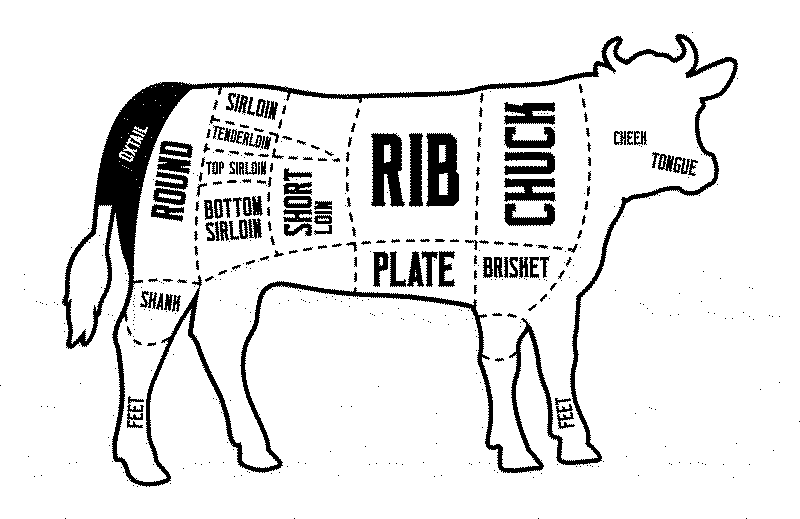
Oxtail is a beef cut that many people overlook due to its seemingly high cost. However, compared to other cuts of beef or meat, the cost of oxtail is quite reasonable. In fact, oxtails are considered a delicacy in many cultures and are often used to make flavorful stews, soups, and braises. To understand why oxtail is an excellent value for its cost, we need to compare it to other beef and meat cuts. Let’s look at some of the most popular cuts and their prices.
- Ribeye Steak – Ribeye steak is one of the most popular cuts of beef, known for its marbling and tenderness. However, it also comes with a high price tag, costing anywhere from $15 to $25 per pound.
- Sirloin Steak – Sirloin steak is a leaner cut of beef that is still quite flavorful. It is also more affordable than ribeye, with an average cost of around $8 to $13 per pound.
- Ground Beef – Ground beef is a versatile meat used in many dishes. It is also one of the most affordable cuts of beef, with an average cost of around $3 to $6 per pound.
- Filet mignon is a highly prized beef cut known for its tenderness and mild flavor. Depending on the quality and where you purchase it, filet mignon can cost anywhere from $20 to $50 per pound.
- Oxtail – As we mentioned earlier, oxtail can be quite expensive compared to other cuts of beef or meat. Oxtail can cost anywhere from $10 to $15 per pound, depending on where you purchase it.
Now, let’s compare these prices to the cost of oxtail. Oxtail typically costs around $10-15 per pound, making it more affordable than ribeye steak and slightly more expensive than sirloin steak. Considering that oxtail can be used to make delicious and hearty dishes, its cost becomes even more reasonable.
One of the reasons that oxtail is so flavorful is that it contains a lot of connective tissue and bone marrow. This means that it takes longer to cook than other cuts of beef, but once it is cooked, it becomes tender and rich in flavor. Oxtail can be used in various dishes, from traditional stews and soups to modern recipes like tacos and sliders.
In addition to its great flavor and reasonable cost, oxtail is also a great choice for those looking for a more sustainable meat option. Because oxtails come from the cow’s tail, they are often considered a byproduct of the beef industry. This means that they are a more eco-friendly choice than other cuts of beef, which can contribute to environmental issues.
What Are The Nutritional Benefits Of Including Oxtail In Your Diet?
Oxtail is a flavorful and nutrient-dense cut of beef that is often overlooked in Western cuisine. However, it has been a staple in many other cultures for centuries, revered for its rich taste and health benefits. We will explore some nutritional benefits of including oxtail in your diet.
- Rich in protein: Oxtail is a great source of protein, with a 3.5-ounce serving containing around 22 grams of protein. Protein is essential for building and repairing tissues in the body, making it an essential nutrient for anyone looking to maintain or build muscle mass.
- High in healthy fats: While oxtail is a fatty cut of meat, much of that fat is healthy for you. Oxtail is high in monounsaturated and polyunsaturated fats, which can lower your risk of heart disease and stroke. These healthy fats can also help your body absorb important vitamins and minerals, like vitamin A and iron.
- Packed with vitamins and minerals: Speaking of vitamins and minerals, oxtail is a great source of many essential nutrients. It’s particularly high in vitamin A, which is important for healthy eyes and skin. Oxtail also contains iron, a mineral that’s essential for forming red blood cells and carrying oxygen throughout the body. Additionally, oxtail is a good source of zinc, which plays a role in immune function and wound healing.
- Supports joint health: Oxtail contains a high amount of gelatin, a protein formed when collagen breaks down. Gelatin has been shown to help improve joint health by reducing inflammation and promoting the growth of new cartilage. This makes oxtail a great choice for anyone with joint pain or arthritis.
- Boosts immune function: Finally, oxtail contains various nutrients that can help support immune function. In addition to zinc, oxtail is high in vitamin B12, which is important for producing red blood cells and DNA. Vitamin B12 also plays a role in maintaining healthy nerve function and can help prevent anemia.
Are There Any Health Concerns To Be Aware Of When Eating Oxtail?
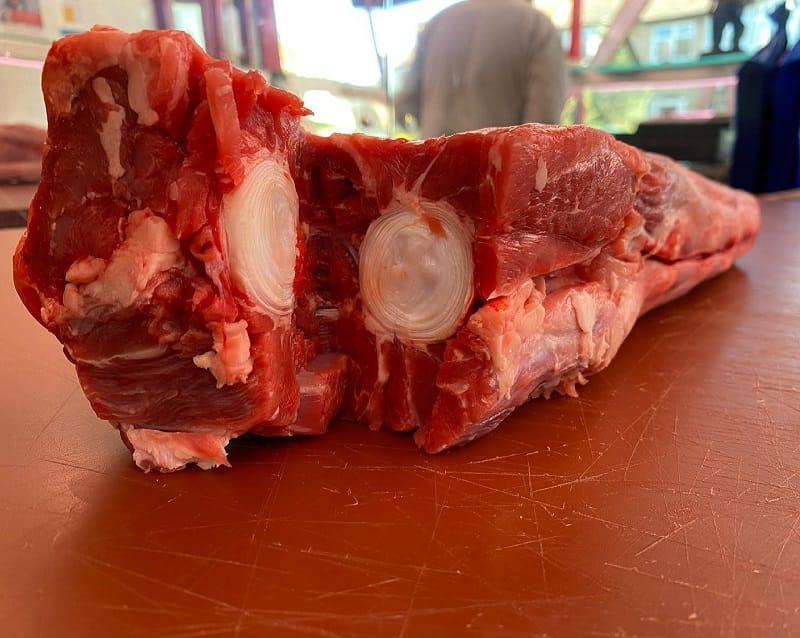
Oxtail is a popular dish in many cultures around the world. The meat is flavorful, tender, and often used in stews and soups. However, some people may be concerned about eating oxtail’s health implications. Now, we’ll explore some of the potential health concerns associated with consuming this meat.
- Fat Content: Oxtail contains significant saturated fat, which can raise cholesterol levels. To reduce the fat content of your oxtail dish, trim off any excess fat before cooking. Also, try using low-fat cooking methods such as braising or slow cooking.
- Sodium: Oxtail is also high in sodium. Too much sodium can lead to high blood pressure, increasing the risk of heart disease and stroke. One serving of oxtail can contain up to 800 mg of sodium. To reduce sodium intake, use low-sodium beef broth or water when cooking oxtail. You can also season your dish with herbs and spices instead of salt.
- Cholesterol: Oxtail contains significant cholesterol, which can contribute to plaque buildup in the arteries. This can lead to heart disease and other health problems. To reduce your cholesterol intake, limit your consumption of oxtail or choose leaner cuts of meat. You can also balance your diet with plenty of fruits, vegetables, and whole grains.
- Antibiotic Residues: Finally, some people may be concerned about the potential presence of antibiotic residues in oxtail. Antibiotics are often used in the beef industry to promote growth and prevent illness. However, overuse of antibiotics can lead to the development of antibiotic-resistant bacteria, which can make it harder to treat infections in humans. Choose organic or grass-fed beef whenever possible to reduce your exposure to antibiotic residues.
How to Cook Oxtail?
Cooking oxtail may seem intimidating at first, but it’s quite simple. Following these easy steps, you can perfectly cook oxtail and impress your friends and family with your culinary skills.
Step 1: Trim and Soak
Before cooking your oxtail, you’ll want to trim excess fat. Rinse the oxtail under cool running water and add it to a large pot filled with water and 1 tsp salt. Ensure the oxtail is fully submerged in the water and let it soak for 1-2 hours.
Step 2: Boil
After the oxtail has soaked, discard the water and refill the pot with 12-15 cups of water, broth, or half and half. Cover the oxtail to fully submerge, and bring the liquid to a low boil.
Step 3: Skim
After 2 hours of boiling, you’ll start to see foam or fat rise to the surface. Skim this off with a spoon or ladle to remove any impurities.
Step 4: Season and Simmer
Next, add your desired seasonings – we recommend pepper and minced garlic, but you can get creative with this step! Simmer the oxtail for a good 3 hours, making sure that the pot is slightly covered if desired.
Step 5: Let it Simmer
To ensure that your oxtail is tender and flavorful, let it simmer for 5 hours on low heat.
Step 6: Serve
Once your oxtail is fully cooked, remove the pieces from the pot and place them on a cutting board. Remove the meat from the bone and serve it as desired. You can also use the meat to make a delicious soup or stew!
Common Mistakes To Avoid When Cooking With Oxtail
Cooking with oxtail can be a challenging experience, especially if you’re new to it. There are some common mistakes that people make when cooking with oxtail that can ruin the dish. Here, we’ll review some of the most common mistakes to avoid when cooking with oxtail.
- Not Cleaning the Oxtail Properly: Cleaning the oxtail is an important step many overlook. The oxtail has a lot of fat, cartilage, and connective tissue that needs to be removed before cooking. You may have a tough and chewy dish if you don’t clean the oxtail properly.
- Overcooking the Oxtail: Oxtails are a tough cut of meat that requires slow cooking to make them tender. However, overcooking the oxtail can make it dry and tough. The ideal cooking time for oxtail is around 3-4 hours, depending on the recipe.
- Not Browning the Oxtail: Browning the oxtail is an important step that adds flavor and color to the dish. Browning the oxtail also helps seal the juices, making the meat more tender and flavorful.
- Using Too Much Liquid: When cooking with oxtail, it’s important to use the right amount of liquid. Too much liquid can dilute the dish’s flavor and make it soupy.
- Not Allowing the Oxtail to Rest: Allowing the Oxtail to rest after cooking is an important step many overlook. Resting allows the juices to redistribute throughout the meat, making it more tender and flavorful.
The Best Spices And Seasonings To Use With Oxtail?
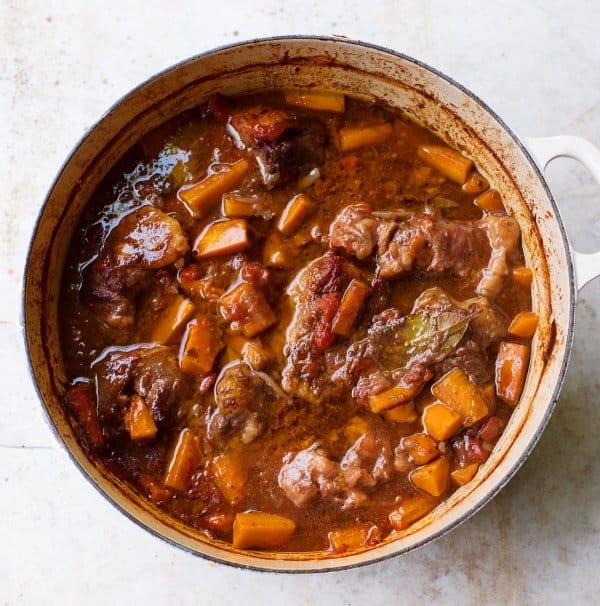
It would help to use the right spices and seasonings to bring out the best in oxtail. Here are the best spices and seasonings to use with oxtail.
- Bay Leaves: Bay leaves are a classic seasoning for any stew or soup. They have a subtle, earthy flavor that pairs perfectly with rich, hearty meats like oxtail. To use, add a few to your pot while cooking your oxtail.
- Thyme: It has a slightly floral and earthy flavor that complements the beefy taste of oxtail. Thyme also has a slightly sweet aroma that adds an extra dimension to your dish. Add a few sprigs to your pot while cooking your oxtail.
- Garlic: Garlic is a staple in many dishes and is an excellent addition to oxtail stews and soups. It has a pungent and slightly sweet taste that adds depth to your dish. Garlic also has a strong aroma that adds an extra layer of flavor. To use garlic, chop a few cloves and add them to your pot while cooking your oxtail.
- Onion: Onions have a slightly sweet and pungent taste that complements the rich flavor of oxtail. Onions also have a slightly tangy aroma that adds an extra dimension to your dish. Chop them into small pieces and add them to your pot while cooking your oxtail.
- Paprika: Paprika is a spice that is commonly used in Hungarian cuisine. It has a slightly sweet and smoky flavor that pairs perfectly with the rich taste of oxtail. To use paprika, sprinkle a small amount over your oxtail while cooking.
- Cumin is a spice commonly used in Mexican and Middle Eastern cuisine. It has a slightly bitter and earthy flavor that adds depth to your dish. Cumin also has a warm and slightly sweet aroma that complements the beefy taste of oxtail. To use cumin, sprinkle a small amount over your oxtail while cooking.
- Red Pepper Flakes: Red pepper flakes are a great way to add heat to your oxtail dish. They have a slightly spicy and pungent flavor that pairs well with the rich taste of oxtail. Sprinkle a small amount over your oxtail while cooking.
How Long Does It Typically Take To Cook Oxtail, And What Are Some Strategies For Speeding Up Or Slowing Down The Process?
Oxtail is a tough meat that requires a long cooking time to become tender and flavorful. On average, it takes around 3-4 hours to cook oxtail fully. However, the exact time can vary depending on several factors, such as the size of the oxtail pieces, the cooking method, and the temperature.
If you’re cooking oxtail in a slow cooker or a Dutch oven, you can expect it to take around 4 hours on high heat or 6-8 hours on low heat. If you’re cooking oxtail on the stovetop, it may take slightly less time, around 3-4 hours, depending on the size of the oxtail pieces.
If you’re short on time and need to speed up the cooking process, you can try a few strategies. Here are some tips:
- Cut the oxtail into smaller pieces. The smaller the pieces, the faster they will cook. This will also help the meat to cook more evenly.
- Use a pressure cooker. A pressure cooker can significantly reduce the cooking time of oxtail. It can cook oxtail in around 45 minutes to an hour.
- Increase the heat. If you’re cooking oxtail on the stovetop, you can increase the heat slightly to speed up the cooking process. However, be careful not to burn the meat.
On the other hand, if you have plenty of time and want to slow down the cooking process, you can try a few strategies. Here are some tips:
- Use a slow cooker. Slow cookers are perfect for cooking oxtail slowly over a long period. They allow the meat to cook at a low temperature, resulting in tender and flavorful meat.
- Cook oxtail on low heat. If you’re cooking oxtail on the stovetop, you can cook it on low heat. This will help the meat to cook slowly and become more tender.
- Marinate the oxtail. Marinating the oxtail before cooking can help to tenderize the meat and add flavor. You can marinate oxtail for several hours or overnight before cooking.
What Are Some Good Sides Or Accompaniments To Serve With Oxtail?
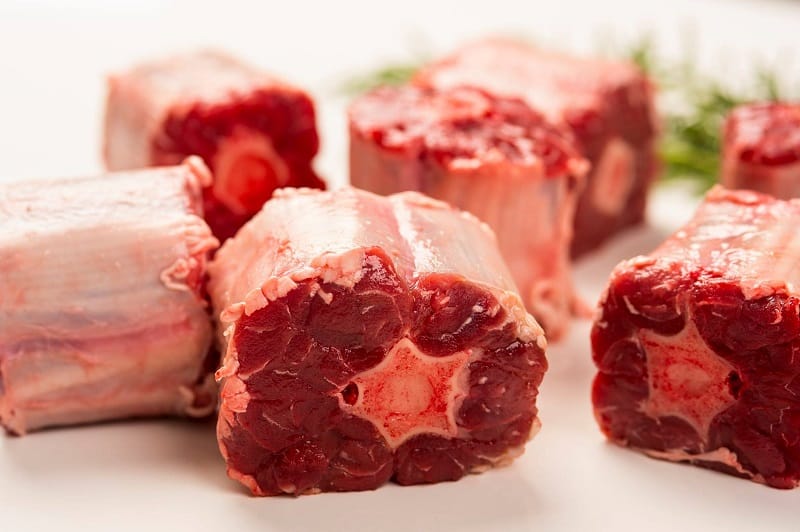
The key to enjoying the full flavor of oxtail is to serve it with the right sides or accompaniments. Now, we will explore some of the best sides and accompaniments to serve with oxtail. Whether you are planning a casual dinner party or a special occasion meal, these sides will elevate the flavor of your oxtail dish to a whole new level.
- Mashed Potatoes: Mashed potatoes are a classic side dish that pairs perfectly with oxtail. The creamy texture and rich flavor of the potatoes complement the tender meat and its savory sauce.
- Rice: Whether steamed white rice or flavorful pilaf, rice is a versatile and filling side dish that can be customized to your liking. You can also add some veggies like carrots or peas to the rice for an extra boost of nutrition and flavor.
- Roasted Vegetables: Roasting vegetables brings out their natural sweetness and caramelizes them, making them even more flavorful. Some great vegetables to roast include carrots, sweet potatoes, and Brussels sprouts.
- Cornbread: The sweet and savory flavors complement the rich and savory flavors of the meat. Add some honey or butter to the cornbread for extra sweetness and richness.
- Collard Greens: They have a slightly bitter taste that pairs well with the rich and savory flavors of the meat. You can cook the collard greens with some bacon, onion, and garlic for added flavor.
- Macaroni and Cheese: The creamy and cheesy flavors of the macaroni and cheese complement the tender meat and its savory sauce. Add some breadcrumbs or bacon to the mac and cheese for texture and flavor.
How To Store Oxtail?
If you won’t use your oxtail right away, it’s important to know how to store it properly to ensure maximum freshness and flavor. Here, we’ll share some tips and tricks for storing oxtail so that you can enjoy it at its best.
- Refrigerate or Freeze Immediately: The first step to storing oxtail is to refrigerate or freeze it as soon as possible after purchase. If you plan to use the oxtail within three days, simply refrigerate it in its original packaging. If you don’t plan to use it within three days, wrap it tightly in plastic wrap or aluminum foil and store it in the freezer.
- Label and Date: Whether you’re storing oxtail in the refrigerator or freezer, it’s important to label and date it to know when it was purchased and when it should be used. This will help you avoid confusion and ensure you’re using fresh oxtail in your recipes.
- Use Airtight Containers: If you’re freezing oxtail, it’s best to use airtight containers or freezer bags to prevent freezer burn and keep out any odors. If you’re storing oxtail in the refrigerator, use airtight containers or wrap it tightly in plastic or aluminum foil.
- Freeze in Portions: If you’re freezing oxtail, consider portioning it before freezing. This will make it easier to thaw and use later on, as you’ll only need to defrost the amount you need for your recipe.
- Thaw Safely: When you’re ready to use your frozen oxtail, it’s important to thaw it safely. The best way to do this is to transfer it from the freezer to the refrigerator and allow it to thaw overnight. Alternatively, you can use the defrost function on your microwave to thaw it more quickly.
- Use Within Three Months: If you’re freezing oxtail, it’s best to use it within three months for optimal freshness and flavor. If you’re storing it in the refrigerator, use it within three days.
Where To Buy Oxtail?
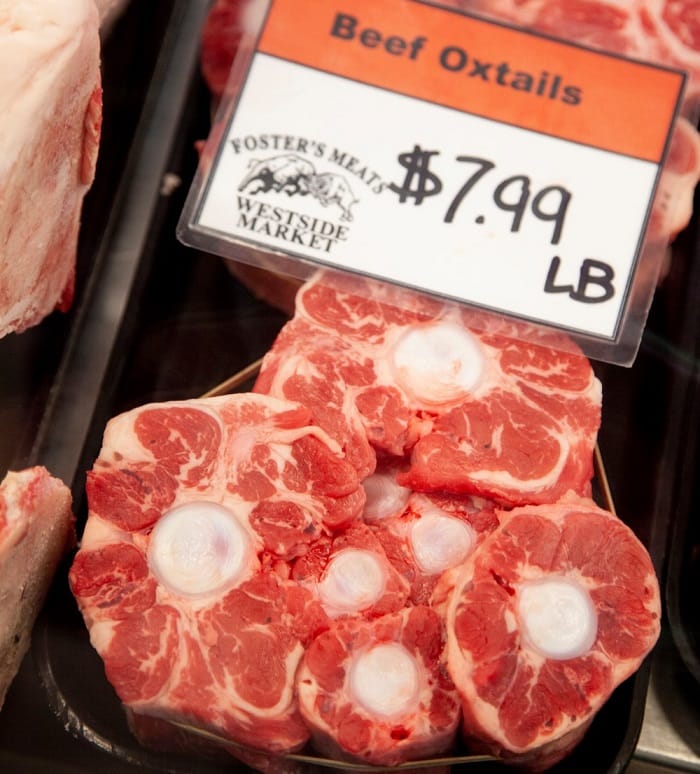
Depending on where you live, you may be able to find oxtail at your local grocery store or butcher shop. Look for it in the meat section, usually near the beef shanks or other tough cuts of meat. If you can’t find it at your local grocery store, try specialty markets that cater to specific ethnic cuisines. For example, Asian markets often carry oxtail, a popular ingredient in many Chinese, Korean, and Vietnamese recipes.
Another option for buying oxtail is to order it online. Many online meat retailers offer high-quality cuts of beef, including oxtail. Look for reputable retailers specializing in grass-fed and organic meats to ensure you get the best possible product. Some popular online meat retailers include ButcherBox, Crowd Cow, and Thrive Market.
If you’re lucky enough to live near a farm or ranch that raises grass-fed beef, you may be able to buy oxtail directly from the source. Many small-scale farmers and ranchers sell their meat directly to consumers through farmers’ markets or online ordering. Not only will you be supporting local agriculture, but you’ll also be getting the freshest possible meat.
Conclusion
So, what is oxtail? It is a versatile and flavorful cut of meat that has been enjoyed for centuries. Oxtail is a nutritious and delicious protein source that can be a great addition to any cuisine. It is often found in stews, soups, and braises, where its rich flavor and tender texture can shine. Whether you use it in a classic stew or try a new recipe, oxtail will surely add a unique flavor and texture to any dish. Give it a try and discover why this cut of meat has stood the test of time.

Hey readers! Chip Holland here, and I’m a Manager of this website. My passion for writing about it only matches my passion for BBQ. Follow my blog for mouth-watering recipes, tips, and tricks for the perfect smoke, grill, and BBQ. I’m sure you won’t be disappointed!
